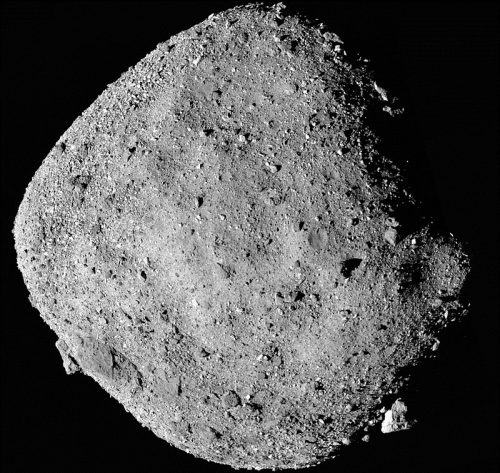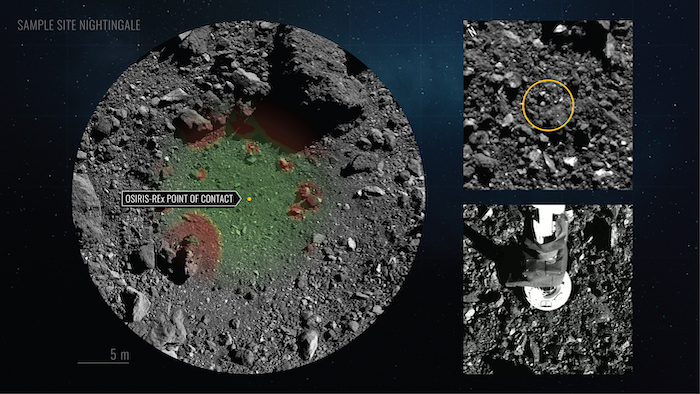At this point, we've become kind of blasé—or unfazed—about the human ability to land probes on bodies in space. This website is full of stories of crafts sent to moons near Saturn, or landers on Mars. Hey, it's just what we do!
But in truth? Outer space is a vast field of openness. One where nothing stands still—always spinning and tumbling! In outer space, even a massive planet like Jupiter is like a pebble drifting in an ocean. Tiny and alone. Can you picture it?
Okay, then picture this. NASA just landed a probe on an asteroid.
Not a planet, not a moon. An asteroid. If Jupiter is like a pebble in a vast sea, then an asteroid is barely an atom. And humans landed something on this? What an achievement!
Bennu and the jets

The asteroid Bennu. (NASA)
The asteroid in question is called Bennu. It is sort of sphere-shaped and is a little over 550 metres (1,800 feet) across. That's about the height of the CN Tower. Big on Earth, sure. But again, in space? And around 320 million kilometres (200 million miles) away from Earth? That really is tiny.
The probe that touched down on Bennu is called OSIRIS-REx (short for Origins, Spectral Interpretation, Resource Identification, Security-Regolith Explorer). It was actually launched in 2016 (which we wrote about here) and reached Bennu in December of 2018. Since then, it has been orbiting, studying, and photographing the asteroid. It was also trying to figure out the best moment and place on the asteroid to attempt a brief landing as that it could collect samples.
Samples that it would bring back to Earth.
Touchdown!
It was finally decided that that day was going to be October 20, 2020. OSIRIS-REx landed and collected what is believed to be about 60 grams worth of rock from the surface of the asteroid. Even better, the landing was caught on camera!
Now streaming HD video from 320 million km away is super hard. But the video that you're about to see is a time-lapse of about 80 photos taken in very quick succession as the landing occurred. It's as close to a smooth video as we can get.
Watch it now!
Why land on an asteroid?
You might rightly ask why scientists would land on an asteroid in the first place. Bennu is what is known as near Earth asteroid. This means that it is close to our planet.
There is even a real chance that it might one day collide with Earth, though this risk doesn't actually get that serious for another century and a half. Until then, scientists want to study Bennu and understand what it is all about.
In addition, asteroids like this are leftovers from the formation of the solar system, billions of years ago. Millions of asteroids just like Bennu have hit Earth in its ancient past. Many theories exist saying that critical elements were brought to our planet by these asteroids, like how a farmer would seed soil.
For these reasons, Bennu is a great subject for study. So how long will we have to wait to see what OSIRIS-REx found? It is supposed to leave its orbit around Bennu in March 2021 before returning home in 2023. We're excited to hear about what it found!
 An image of the site where the sample was collected by the NASA probe OSIRIS-REx. (NASA/Goddard)
An image of the site where the sample was collected by the NASA probe OSIRIS-REx. (NASA/Goddard)










Wow i want that news share in television any week. Fot much video from ISS, space